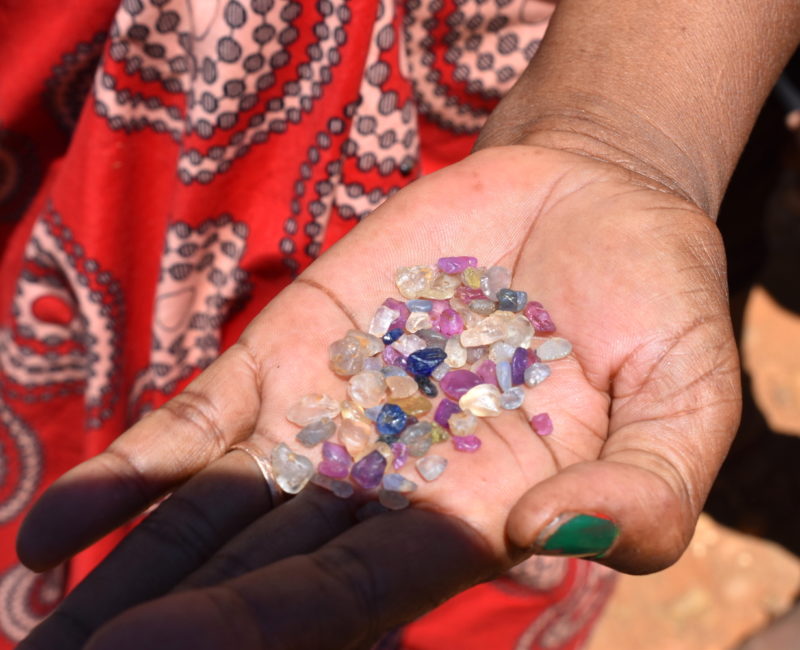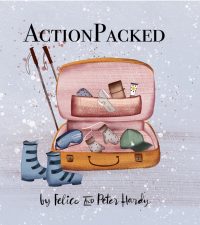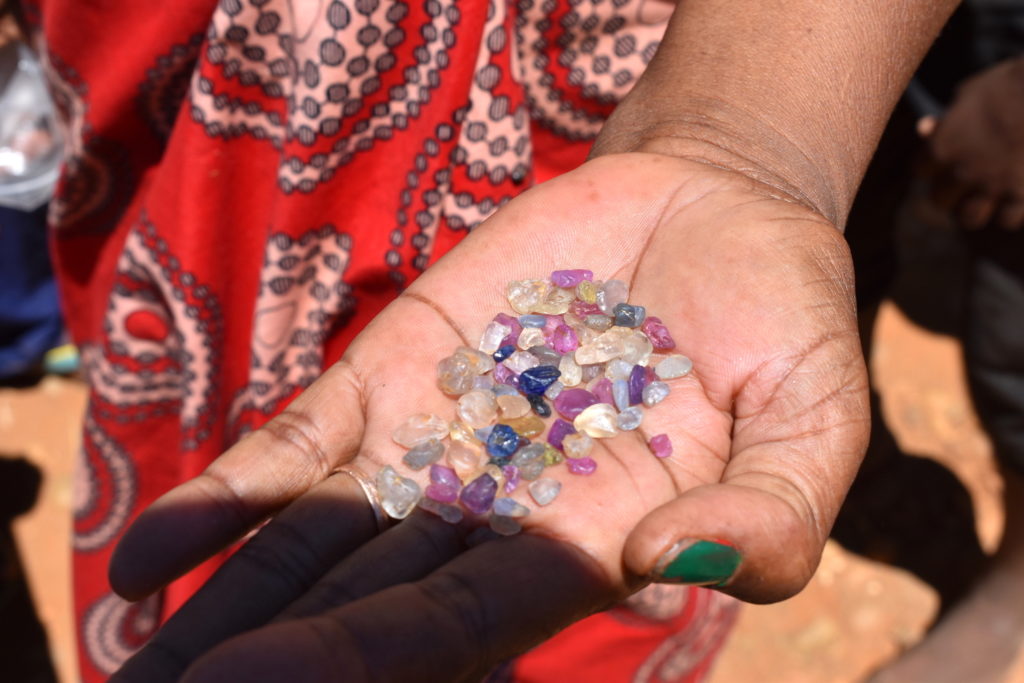
Sapphires in Madagascar
This week, we’re looking at the extraordinary career of Joanna Hardy. She’s one of the world’s leading experts on jewellery, £1m rubies, diamonds and emeralds are her bread and butter. For the past 14 years, when not pursuing her own career as a gemologist, she’s been a leading light of the BBC Antiques Roadshow.
Peter Joanna Hardy, welcome to our travel podcast. We’ll come back in a minute to wear your remarkable career began but first of all tell us about what it’s like to be involved with the Antiques Roadshow?
Joanna Yes, I’ve been on Antiques Roadshow for 14 years now. Obviously, I’m still waiting to see if we can film a few this year, hopefully, but we don’t know yet – need to see how things go. But yes, every day when you go on one of these locations, I don’t know what I’m going to see or find. I’ve got absolutely no idea. And of course, the majority of people there have no clue either, so it’s all quite nice. I don’t know what they’re going to bring and they don’t know what they have. So that generates huge amounts of excitement. The trouble is, when I find something very exciting, to not give the game away because I don’t say anything to anybody until it’s on camera – so it’s absolutely first-hand because you can’t get the general public to go ‘ooh..aah’ twice as enthusiastically as the first time. So you need to have that element of surprise.
But sometimes when I even see a box, my heart starts racing because a particular style of box will give me an indication of what might be inside. Often it’s not. Often it’s just the box and the piece is long gone, but it’s very exciting to hear people’s stories. You know, sometimes the things that don’t get filmed…I’ve seen some amazing pieces from a story point of view. They might not be worth very much, but I find them very potent. But yes, I have seen such an eclectic mix on the road show, which is great. And that’s the fun of the Antiques Roadshow.

Working as jewellery expert on BBC Antiques Road Show
Peter Now, you started your career in jewellery when you were still in their early teens. You went to Bedales in Hampshire, which is renowned for its alternative and creative approach to school work.
Joanna Well, it was a very creative school. I was very lucky that I went to a school where jewellery and making things was as important as being in the chemistry lab. I think I was very lucky about that, because I didn’t like the chemistry lab very much and I wasn’t very good at it either. So to actually be in this amazing workshop where you could make jewellery, turn wooden bowls…and we had incredible teachers, very inspiring teachers, and that is what it’s all about. And so I very quickly got the bug. When I was 14, I made my first piece of jewellery and that just sparked an interest which has never left me since then.
Then I went up to Sir John Cass College to start a three-year goldsmithing and silversmithing course. And I was living in those prefabs by Three Colts’ Lane and Vallance Road. It was where the Krays used to hang out, apparently. And it was one of these prefabs, these asbestos huts that were leftover from the War that they rented out to students for £9 a week. And that’s where I stayed for a while. Now, looking back, the East End in that period in time was very interesting – it was quite rough and ready, it’s so gentrified now I don’t recognise the place – but back then it was quite an exciting time.
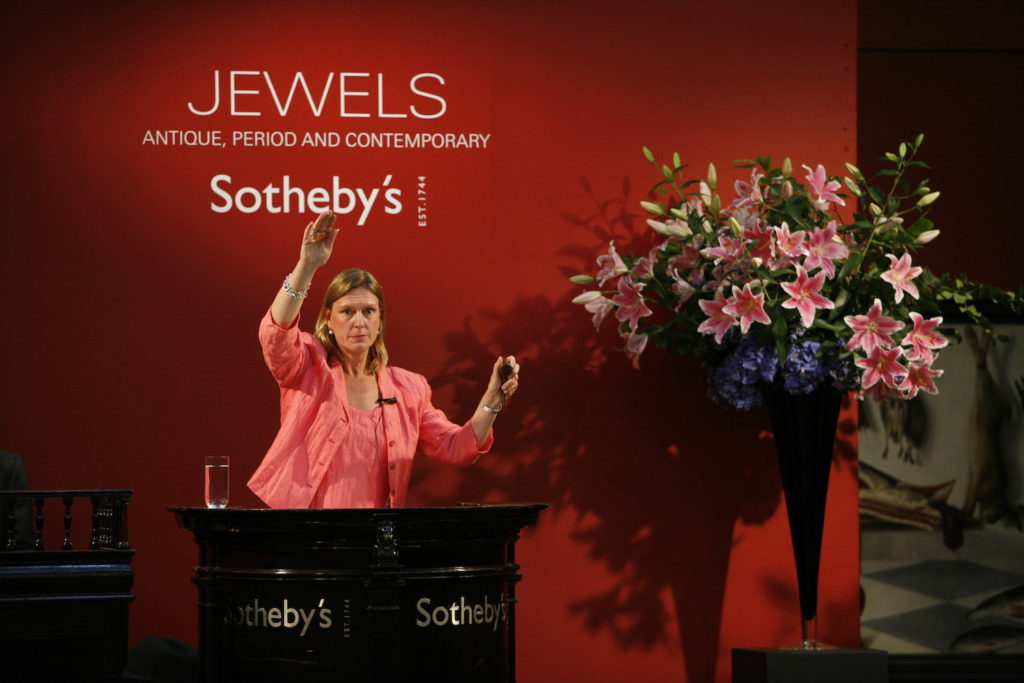
Working as an auctioneer at Sotheby’s in London
Peter And if you want to be involved in diamonds, you have to go and work for De Beers at some stage in your career? And that’s what you then did.
Joanna Yes, I wasn’t very good at making jewellery, I learned that very quickly. I enjoyed it. And while I was at the John Cass College, I trained as a gemologist, so I learnt about gems in the evenings. And then I worked as a Saturday girl in Hatton Garden. And with that, I then became a full-time sales assistant selling rubbish at the time in Hatton Garden, that was just very uninspiring jewellery. It gave me a living, but I just thought there must be more to this. I loved jewellery, I loved the gemology, but I didn’t like the gold chains I was selling.
There’s a fruit and veg market behind Hatton Garden called Leather Lane and I met someone there and they said: ‘De Beers are looking for somebody. Why don’t you go and apply?’ And I said: ‘Well, who are De Beers? I’ve never heard of them.’ And they said: ‘Well, they only own about 90% of the world’s diamond mines.’ And I thought, oh well, I’ll go along.
So off I toddled, not knowing very much, for the interview. And surprise, surprise, I got the job and I became a rough diamond valuer and sorter. And that was an incredible opportunity to discover a world which I knew nothing about. I mean, I had no idea what this world would have led me into, but it was with gems. And there was nowhere else in the world at the time that you could learn to grade and value rough diamonds – because there’s 12,000 categories a rough diamond goes into.
But as soon as I went there and I heard very quickly from young men coming into the office: ‘I’m going off to learn French’ because they were going to be buyers in the depths of Africa,’ and I thought: ‘Hang on…I want to do that, that sounds ideal.’ I’d go off to the Congo and Angola and buy all the diamonds that have been smuggled over the borders. I thought, that’s terribly exciting, I quite fancied that Indiana Jones gung-ho sort of a job. But I was a young girl so that wasn’t going to happen, and I quickly realised that it was very much a male world and there was no place for me in the bush buying diamonds for De Beers.
So it was then that I just saw an advertisement in The Retail Jeweller for a polished diamond dealer, an assistant polished diamond dealer in Antwerp. And I thought, well I don’t know anything about polished diamonds, but it’s not Africa it’s Antwerp, but it’s better than the UK. So I thought I’d apply. And it was the audacity of youth, really. I just sort of went for it. And I didn’t realise that actually having worked for De Beers gave me huge amounts of credibility, which I had no idea at the time. And the guy that hired me, he could see a young girl selling his diamonds in a very Orthodox Jewish environment might actually work to his advantage with the wholesalers at the time.
So I got the job. I went over to Antwerp in my Ford Fiesta. I rented this flat in the Provinciestraat just near the zoo, Antwerp Zoo. And my first day of going down the diamond district and into the office and I met the person I was going to be the assistant to – Mr Nico Van Ghent. And he threw me a parcel of diamonds and he said: ‘Right, sort those into the various categories.‘ And he went away and I looked at this parcel of diamonds; I didn’t know where to begin. So I sort of fiddled around with the diamonds.
Then he came back and he said: ‘You haven’t done anything.’ And I said: ‘I actually don’t know what to do.’ He said: ‘Have they sent me over someone who doesn’t know anything?’ And I sort of nodded my head and said: ‘Yes. I’m afraid they have.’ He said: ‘Well, you’re here now. I’d better train you.’ So I stayed until I was 28 years old – from 21 to 28. I stayed and learned how to be a diamond dealer. And that was, when I look back, incredible because I was on commission. I’m not Jewish; I was a young girl. During the day, I’d be learning to deal with brokers who were mainly Orthodox Jewish gentleman; sometimes ladies. But when I was out on the street, I was ignored, I didn’t exist. But I found the whole thing very fascinating; Antwerp was a great place to live because I very quickly found out there’s a whole underground of wonderful music and cafes, and it was a very inspiring place for young people actually, at the time.
But I was given two patches. I was given Scandinavia as my patch to sell. So in the diamond world, you’ve got buying areas which were mainly Antwerp, New York, Tel Aviv and Mumbai – those were where the cutting centres were. And then I was given Scandinavia as my patch to go and find the wholesalers and go and sell my diamonds.
So I would pack my suitcase. I never carried a briefcase as that all looked a bit obvious, but I used to have just a small bag within a bag full of diamonds, probably £1m worth, I suppose, at the time – something like that. They were all samples. And I was like a second-hand salesperson off I went to Helsinki, to all over Sweden: Malmo, Stockholm. Then I’d go to Norway, to Bergen, Stavanger, Oslo, to Denmark. And I would literally get to the hotel, put the diamonds in the hotel safe, go up to my bedroom, look at the Yellow Pages because there’s no mobile phones, there’s no internet. And I looked for diamond manufacturers and I phoned them up – diamond manufacturers and lots of people that were making jewellery. And I would phone them up and say: ‘Would you would you like to see some diamonds?’ That’s it.
Then off I’d toddle with my diamonds and show them. And then because it was all on a carnet so I had to just take the orders. So I took the orders and I then went on to the next place. And for three weeks I would be on my own – I was 24 years old when I started – and I mean, honestly, I can’t believe I did that. I wouldn’t be doing anything like that now. But I didn’t even find it that exciting anymore: it was a job and I had to sell diamonds. But quite a few things happened. One was if I walked into a jewellery shop to collect the stones, because sometimes they would ask me to leave the stones with them so they could show their clients – so they could sell the stones – and then give them back to me, and then when I got back to London I’d ship them.
But when they asked me to sit down and have a cup of coffee, when I came into the jewellery shop, I knew that something had gone wrong because they usually would just hand them back to me and then off I’d go. But I knew there was going to be a story attached. There was one time when I was in Copenhagen and the shop owner sat me down and asked if I wanted a cup of coffee. And I thought Oh, here we go. And he said:
‘I’m very sorry, but we don’t have your diamond. We did have your diamond, but we now don’t have your diamond. And not only that but we’d been left a deposit for the diamond, and the money is only printed on one side. So they had their money, they had no deposit and they had no diamond. So that was quite interesting.
But whenever I went through customs, polished, loose diamonds are transparent to x-ray so no-one would see through the x-ray machine for those carrying diamonds. So I would declare it – well it was all on a carnet and I needed all these stamps. But half the time, at the end of customs around the world, they would just take me into a little room because they just want to see a pile of diamonds. So I was getting used to customs officers getting very interested for their own self purposes. So I would do that. And used to go to Scandinavia twice a year and I’d get the orders and then I would have to go and buy the orders.
So I would go with Henry Ginda, who was the gentleman who owned the company, and I’d go to Tel Aviv and we’d sit there in the Diamond Bourse buying, literally we had a shopping list which we’d put in the Bourse so that the brokers could see what we were looking for. And then they will come to us and then we would look at the parcels and say: ‘Yes, we like this or we like this parcel, but we reject this amount.’ I mean, it was exciting.
Then you had to haggle of price, that always was exciting because there was lots of shouting: ‘How much? You must be joking!’ or speaking on the phone to somebody saying: ‘I know they’ve offered this price, it’s a ridiculous price,’ and there’d be no-one on the other end of the phone, it would all be a bit of a show and a shebang. But you all knew that, and when a deal was struck, you would just say, Mizalle! There was no handshake, there was nothing written, it was my word is my bond – and that was how the diamond business conducted itself.
To this day my word is my bond – it’s harder to find – but that’s always been the way that diamond dealing was done. I mean, it’s a very closed world, there’s a lot of trust that’s built up, a lot of respect and reputation. And reputation can be destroyed very quickly if someone does something wrong, because it’s a very small world. And it certainly was a small world then.
Peter And the money printed one side…did you get the diamonds back?
Joanna No, I didn’t get the sample back. There was another time when I was in Stavanger and I had the diamonds in my bag and I just put them up on the in the locker above in the plane when I was on the plane. So I was flying from Oslo to Bergen, but there was a stopover at Stavanger. And I didn’t realise that when we stopped and had to wait for the next lot of passengers to come on board, that it was the changeover of the oil rigs, which is about every six weeks or eight weeks. They would change the workers, and of course they haven’t seen alcohol for about eight weeks.
And all these Swedish men came on board the plane. And I never engaged in conversation with anybody when I was on these trips; I just wanted to keep myself to myself. So I was just sitting there with a book and this guy came and sat next to me, went: ‘Hello?’ And he can speak English, and he could see I was reading an English book and I just tried to ignore him. Anyway, all the beer was flowing, all the alcohol was flowing and I was only 24, 25 years old.
He was saying: ‘So what are you doing?’ ‘I’m on holiday.’ Right. Bergen. And then he started chatting and I tried to ignore him anyway. He said yes, I’m on holiday. And then he said: ‘So how are you getting from Bergen to where are you staying?’ And I said, ‘Well, I’m staying at the SAS hotel,’ which, of course, why would a 25-year-old stay at the SAS Hotel in Bergen on her own as a holiday? It’s a bit weird, but I said: ‘I like the SAS hotel.’ He said: ‘How are you getting there?’ I said: ‘Oh, I’m going by the SAS courtesy bus.’ And he said: ‘No, I’ll take you there. I’ve got some mates. They’re picking us up. We’ll take you to Bergen.’ I just thought in my head, no, you aren’t, you’re not taking me to Bergen.
So it was quite a short trip to Stavanger and when we got to Bergen – Bergen has a big airport, but when I was travelling around there was a hut, it was literally a hut. And I thought, I’ll lose them at Bergen Airport and they’ll forget about me and they will go off.
When I got to Bergen Airport it was a shack and I just thought, oh goodness. I was walking really slowly and I had to go and declare my diamonds to customs and I didn’t want them to know why am I going behind the curtain and customs. And it was literally a curtain. So just before you collect your luggage, you have to go through ‘nothing to declare’ and of course I have to go through the ‘declare’ channel and I thought I’d lost them.
So I was doing everything very slowly, and I thought hopefully the customs officer here will get all excited about diamonds or want to look at them more than I’ll be there for ages. But quite the contrary, because the plane was late, he wanted to get home and didn’t give a monkeys what I was carrying. So he just stamped my carnet and I was out of the curtain in two seconds. And there was just a conveyor belt that stopped about 12 feet down with your suitcases. And that was that. I could see the SAS courtesy bus, the car park, and it was night now. So I grabbed my case and I thought they’ve all gone thank goodness, so I rushed on the bus, sat down. I’m safe now.
Then I heard the chap going: ‘We are going to take you to Bergen. You are not travelling on this bus.’ And so he took my luggage and took it across the car park to his car with his girlfriend and some other mates. So there’s me with my handbag running with the diamonds on me, running across the car park to chase after my suitcase. And they wanted to put my handbag into the boot of the car. ‘No, I like my handbag with me.’ ‘No, it’s fine, it’s safe in the boot.’ I said: ‘I’d really like to have my bag with me.’
Because we’re all scrunched up at the back and out came the beers, out came the joints, and I thought: ‘How am I going to explain to my boss when they find out that I’m actually carrying £1m worth of loose diamonds on me?’ Anyway, I have never had my heart in my mouth like that again, I was just petrified of what could happen, my mind was just racing. But they were as good as their word. They dropped me off at the SAS Hotel in Bergen and said: ‘Well, enjoy your holiday.’ I said: ‘Yes I will now, thank you very much.’
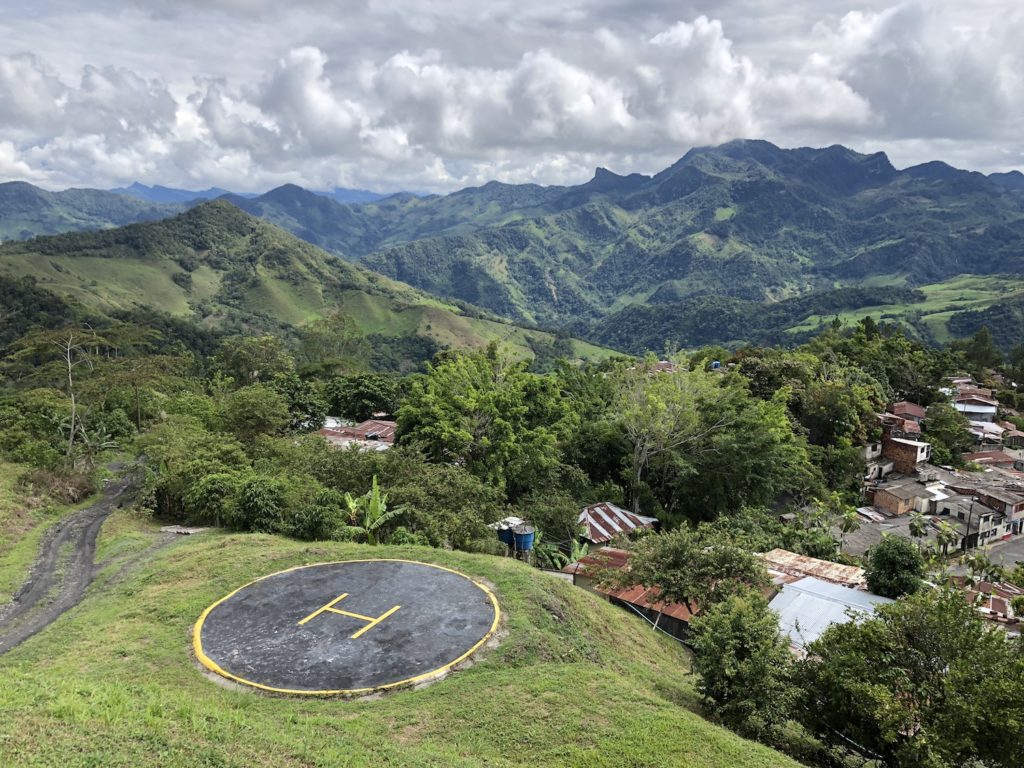
Colombia helipad
Felice How did you move on from diamonds to other gems?
Joanna So I was in the diamond world and I loved it. I got a phone call from Philips, the auctioneers who are now Bonhams, and they wanted a diamond specialist and would I consider working for them? And I just thought, well that’s interesting, I know absolutely nothing about antique jewellery. So I remember when I was in Antwerp, I’d go over to Zeebrugge and just before the interview I’d go over to London, cross by ferry and sit in the V&A or The British Museum jewellery galleries to try and learn about antique jewellery before my interview…so I could sound vaguely knowledgeable when I got to the interview. So anyway, I did that, got the interview, I got the job and stayed at Philips – Philips, Son & Neil it was then, and it was a wonderful training ground for learning about antique jewellery and gemstones in general.
But I think I had the bug of travelling for my work, and I’ve always wanted travel to be integral to my business and my work. And I’ve been so lucky to have managed to do that. I’ve been to countries and places and people that I never ever would have imagined I would have got to see. It’s not so much the countries but it’s the people; it’s the people and the country experiences – that’s what makes it special.

Joanna with sapphires in Madagascar
I love the natural world, and so flying around in Colombia or crossing the Gibb River Road or going down the Gibb River Road in Australia to the Argyle Mine, Myanmar, I love Burma. Madagascar I thought was a beautiful country, and the people were lovely. Well, the people everywhere are lovely, actually. I must say on all my trips and my travels, they’ve been very welcoming and I really love engaging with different cultures.
When I was with Philips I was asked to go to India to look for Mughul jewellery to sell in the Geneva sales, and I just thought I’d gone to heaven. You know, someone was paying for me to go to India, I was travelling around in a rickshaw, popping into jewellers and looking at Mughul jewellery and tried to get them to sell them in Geneva. This was years ago, it’s not quite that simple anymore, but those were the days. I could combine my love of jewellery and also learning about all the different types of jewellery that all these different cultures would have and all the different stones and all that different meanings. You know, it’s very individual all these loves and passions.
I was with Sotheby’s for 14 years and I was an auctioneer and a senior jewellery specialist for them. Since leaving them, which was 11 years ago now, I have had the very good fortune of working with Gemfields who are a mining company, and they are like De Beers of the coloured stone world.

Joanna’s Emerald and Ruby books
They have sponsored a book on emeralds, a book on rubies which I have written, and I’m just embarking on writing a book on sapphires. And that has given me an incredible excuse to go and travel and see all these countries and all the mining areas. I love to be able to see where things have started and where they finish. So I work very closely with Van Cleef and Arpels and Cartier and all the archivists in Paris, and of course the new jewellery that’s being made now.
So for me to be able to actually see where it’s coming from, meet the people who trade in those stones, meet the people that cut those stones to end up in Place Vendome, I find so fascinating. And a piece of jewellery is about a group of people who have put it together; it’s not just one person – it’s been nature, it’s then been man with nature, it’s then been the traders. And then it’s been the goldsmiths, the designers, and then you’ve got the custodians, which are the people who own those jewels. But they only own those tools for the for a period of time before they either pass it on to somebody else. So it’s a journey that involves a lot of people and skills, a lot of skills that have been handed down through generations.
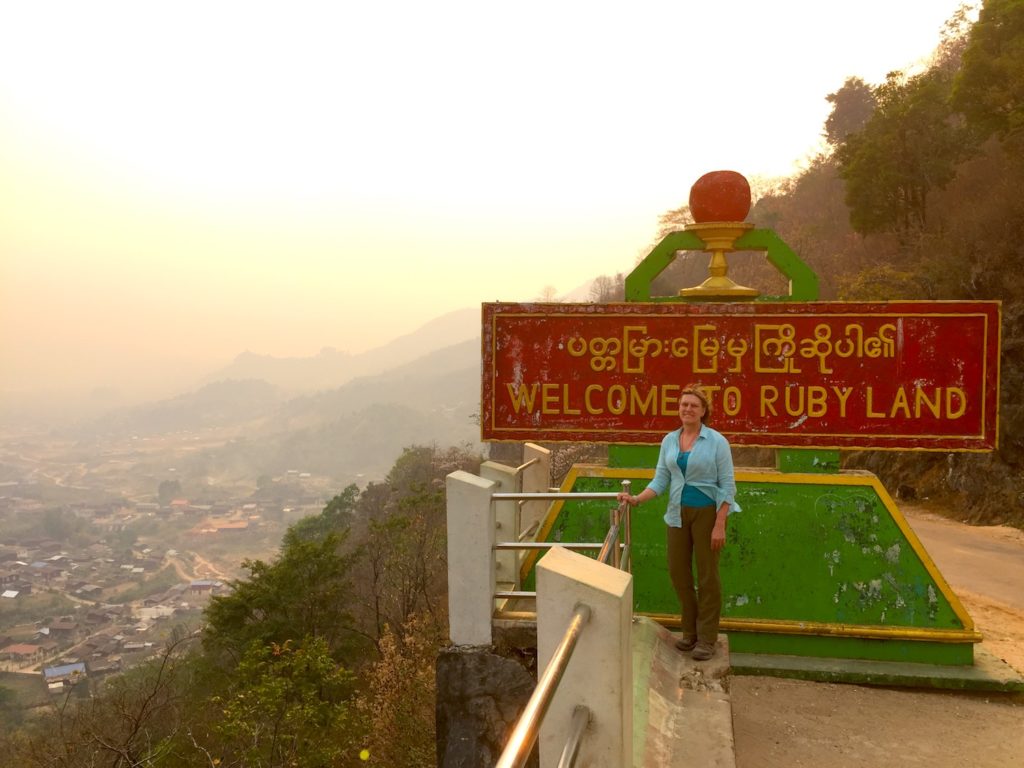
In Mynamar researching rubies
When I was in Burma, in Myanmar, I travelled about seven hours north of Mandalay, an area called Mogok. And I bought a piece of rough ruby, a small but a rough one, from what’s called the cannasei women. Then I got it cut, and the person that cut it – his father and his grandfather were ruby cutters, it’s been a tradition all through their lives and they’re very proud of it.
Then I’ve met one of the biggest ruby dealers in Thailand, and he also cuts his own stones. And so when I showed him my ruby that had been cut by someone in Burma in Magok, and I showed in the video of how they cut the stones, very different to how other people cut stones, it’s unique to Myanmar. This guy is very big in the ruby world and is worth lots of money, but his passion for the subject…there was this cameraderie, this mutual respect for the person in Myanmar. And it didn’t matter about the language, it didn’t matter about money, it was all beyond that – it was understanding each other’s skill set, that’s what I find so beautiful. And when you’ve got people with passion, they will really strike up this very unique relationship with other people who have similar skills in other parts of the world.
So that’s very important. But, you know, there’s no way that I would pick up a stone. Normally I don’t buy stones, that I did as a sort of a one-off. When you’re near a mine you do not pick up anything. You do not pick up a pebble. You do not pick up anything. Because if they think you’ve picked up a stone that might be worth something, I think you would very quickly have a lot of people strip-searching you. So I would stay well clear, I show that I’ve got absolutely nothing as I walk out of a mine. So everyone knows that all the stones are safe, if there are any.
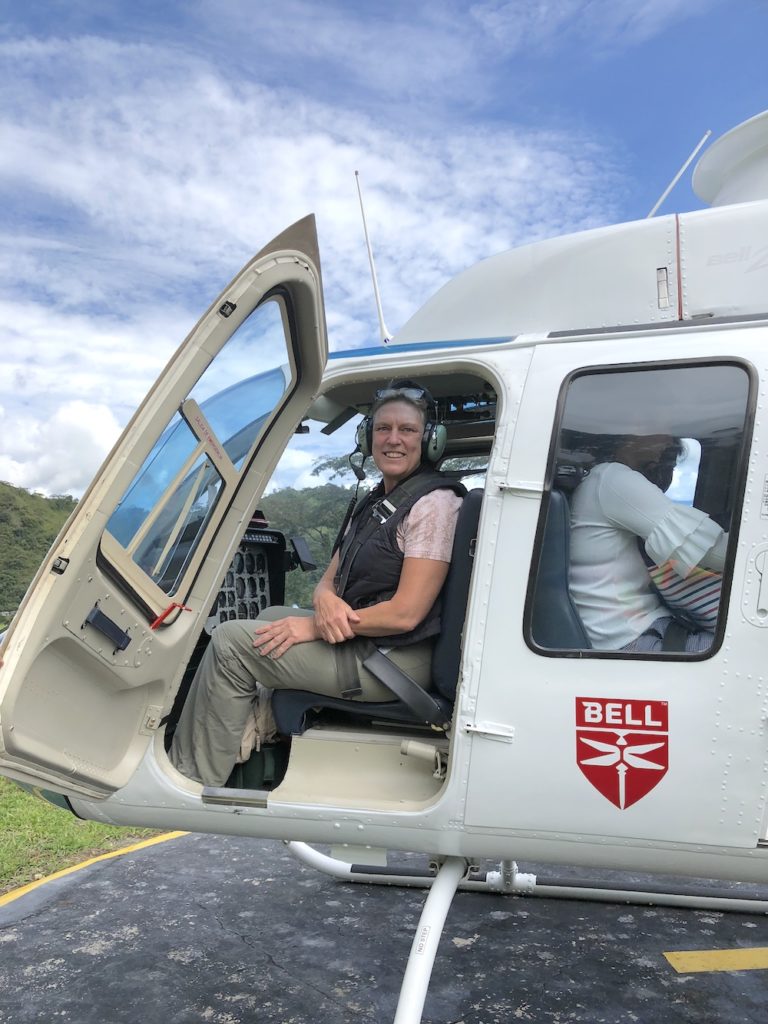
Helicopter in Colombia
Felice You had an interesting experience at an emerald mine in Colombia?
Joanna Yes, Colombia is an astonishing country. I flew to Bogota where I was actually giving a talk on emeralds and then I had the opportunity to go and see an emerald mine, Coscuez, which is owned by a company called Fura. I drove and it took about seven hours. It was quite a rough road and I stayed on the mine for a few days and that was incredible. The landscape was something else; I had never seen such beauty.
The owner of the mine – it was time for me to go back and it was like a seven-hour journey back down – he said: ‘Well, you can you can go back in a helicopter, which would take 50 minutes or something like that.’ And I just thought, oh my goodness…a helicopter, I’m not a very good flyer, even though I fly all over the place. I’m definitely not a good flyer in helicopters, but 50 minutes versus seven hours. And I looked at the countryside and I just thought I can’t miss this opportunity.
So I did go in the helicopter and I just thought if I drop out of this plane, out of this helicopter and die, this would be a very good place to do it in because it was just stunning. And the hills and the mountains and the vegetation was just so green. And to think that all these emeralds are underneath these mountains, nature’s got these green stones beneath, which some of have not seen the light of day for over 50 million years. Just majestic, I think that’s one of the best trips I have done, but I won’t be getting in a helicopter anytime soon – I think that is a very good one to leave on.
Peter By definition because of the extraordinary high value of gems, your job has a substantial element of danger attached to it. Do you ever think your life is threatened?
Joanna Yes, it can be, because there is a lot of money at stake. The material you find in mines is very low grade. You know, to think that you’re going to go to a mine and then you’ll find a fantastic ruby…people can wait years before they can find one of those. So that’s the icing on the cake. We do get a little bit blasé when we see these amazing stones in Bond Street shops or something like that. But I can tell you, it has taken years to get a collection together. The world is not a supermarket. The majority of stones are very low grade. And the icing on the cake are some of these very amazing stones. But nevertheless, there is money.
You have to be very careful because whenever there’s money to be made, that’s always going to attract unsavoury characters. So it is very important that you go with the right people and you do your own due diligence. I do my own due diligence, I will always check who the people are, check quite a few people who know those people I am going to be safe with. And there are times when you do have to be under armed guard there. But that’s I suppose that’s more of a precautionary measure than anything else.
I’ve just come back from Madagascar. There is no large-scale mining there for sapphires; it’s all artisanal mining. I was escorted by two geologists and also someone that lives in Madagascar. And I had also a local Malagasy gentleman, both of whom had been there all their lives obviously, and know the tribes well, they have a great reputation and they trusted and going around with them was better than any gun because they had that respect from the local miners and the local tribespeople.
We travelled about seven hours off-road and then we ended up at this village. We were sitting in this mud hut, really hot. They knew that we wanted to look at the sapphire mines and they wanted to know more about us. But the fact that we had this guy Mark with us, he was our insurance policy. They had heard of him, they had respect for him, they knew him. They agreed to take us to the sapphire mines, which was another 3km trek. We did have an armed guard, they did have one of their guards go with us who had a gun, but told myself that was more for the crocodiles in the river than for us, because whenever we met any miners, they were all lovely people.
But you do have to be careful and very sensitive to the environment that you’re in and to the people that you going to see and remember that it’s their country, not yours. I think that is absolutely paramount when travelling.
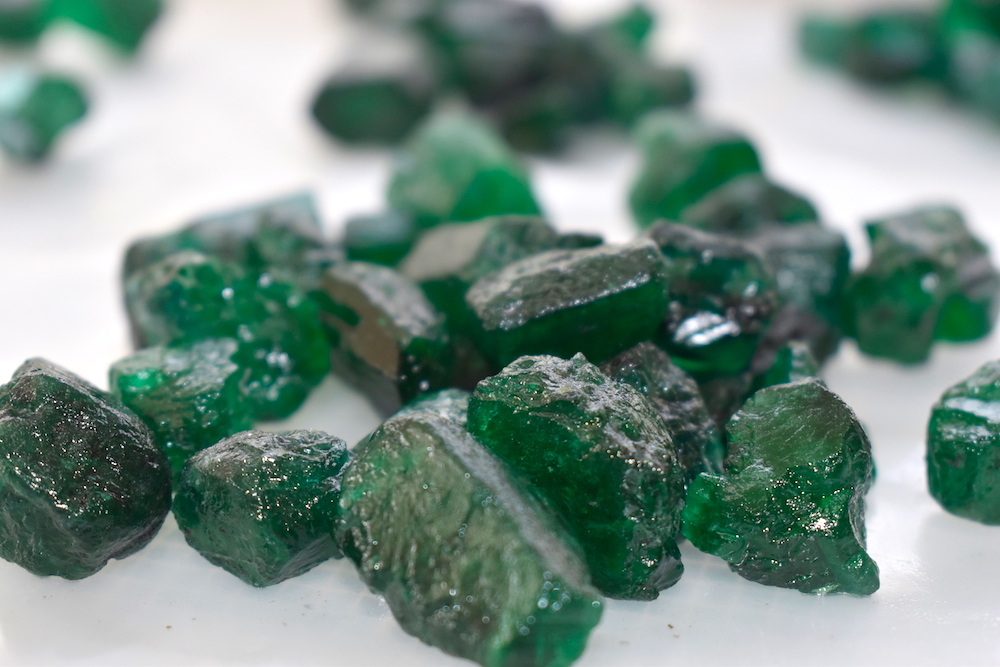
Emeralds from Zambian Kagem Gemfields emerald mine
Felice You once did a valuation in the turrets of a castle?
Joanna Yes. I mean, there’s all sorts of funny places you end up valuing people’s jewellery. And when I was at Sotheby’s, I went to a castle in Scotland. It’s always people that seem to live in very small houses, they’re the ones that are the most hospitable and they’ll make you a cup of tea, give you a piece of cake, and it’s lovely. The bigger the house, the less you get. You’re very lucky to get a dog biscuit. I went to this castle and they said: “Oh yes, we’ll just go up to the turret.’ And I thought, why are we going up to the turret because they couldn’t afford to heat the place. Is it always warmer – heat rises and it’s warmer in the turret than it is down below. So I sat in this turret and if I had a biscuit I was lucky.
Valuing this jewellery so often you find yourselves in situations. There was another castle or something like that similar that I went to and this lady, it took quite a while to find the jewellery, she kept forgetting where she put it because she’d hidden it everywhere. So eventually she found it and then she brought it out to me. And then she would say: ‘Oh, where’s that? Where’s my diamond ring? And why is that not here?’ And then she worked out that her husband had taken a few bits before the divorce. So you do find yourselves sometimes in tricky situations.
I’ve always said that valuing jewellery is 30% knowledge and 70% counselling, because you must always work out why do they want it valued and what their expectations are. I think that’s managing people’s expectations.
Felice Now in lockdown you can’t travel, can you still do you work?
Joanna Yes, I can; I have been. It’s quite interesting because I’m writing this book on sapphires and I’ve been phoning up these amazing private collectors all over the world. Yesterday I was speaking to a sapphire miner’s wife, she was in the outback in the ‘70s and her husband was a miner. And so she was telling me about her experiences in Australia in the outback during the ‘70s, and that was absolutely fascinating. And then in the afternoon, I was speaking to someone in LA who is a private collector. And I just thought, this is brilliant, I’ve been to Australia and Los Angeles all in the space of a morning.
I’ve been speaking to people in Japan and Puerto Rico and New York and all over the place. They would normally be in their private jets all over the place and wouldn’t have time to speak to me, so I’ve got a captive audience at the moment. I think everyone’s sick of talking about the virus and if you can talk about their jewellery collection, they love it. So I’ve had these amazing conversations, very inspirational conversations with people, and so I feel like I’m still travelling actually, I don’t feel like I’ve stopped, which is good, which is great.

Felice You’re also running an online jewellery foundation course?
Joanna Yes, I’ve got this jewellery foundation cause it’s on the platform of learning with experts dot com. So you can also learn about make bread and gardening and photography and all of those things, and you can also learn more about jewellery just out of interest. So my courses are eight one-hour videos about rubies, emeralds, pearls, sapphires, diamonds. It talks about the antique and the contemporary, the fakes, what I look for. We go to the assay office about hallmarking, we go to diamond cutters, enamellers. So that is me engaged in conversation with all these various artisans and dealers, and all the people that make up the jewellery world.
So there’s two levels: there’s one level where you can pay and just watch the one or the eight one-hour videos, or there’s another level where you watch the same videos but I’ve set some tasks which you can do in lockdown. You don’t have to go anywhere, but then I mark it. So it’s up to you which one you do. I highly recommend them, of course.
Felice Sounds great.
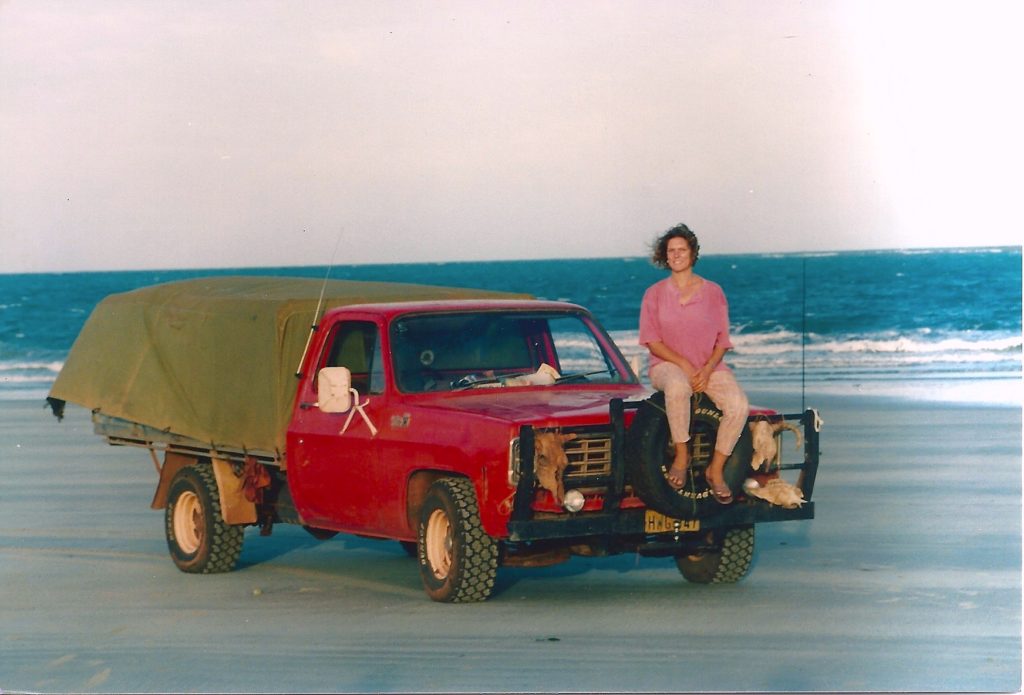
Joanna on her trip from Sydney to Cape York 1993: no mobiles, no internet, the truck was a two wheel drive
Peter Joanna, you once said that you’re the happiest in the wild around a campfire with your family, a glass of wine in your hand. Is that right?
Joanna Absolutely. My husband was a park ranger in Australia, I was in Girl Guides, so I think the Girl Guides started that off.
Peter You once travelled from Sydney to Cape York, the very tip of northern Queensland.
Joanna Yes, it was Sydney to Cape York and that was in a two-wheel drive Chevy truck with three guys. That was when I was travelling around Australia; I took a very late gap year in the ‘90s. And it was supposed to be six months, but it ended up being two years. But on this particular trip, we lived off the land from Sydney to Cape York. We did about 10 creek crossings a day. And I was charged by razorback pigs, and we had bushfires, and we had snakes, and we had a horrible taipan – a taipan snake suddenly got lost in the engine of the Chevy truck, and all these amazing journeys. And we were eating green ants and making dampers, and I’d never been happier. It was absolutely amazing.
We also fished for saratoga and barramundi in the mangrove swamps up at the top. And I went to Punsand Bay and we had our little rubber ducky, we call it rubber ducky – a sort of inflatable boat, in which we went off into the mangrove swamps. And we would tie…ended up being my husband but at the time it was just it was a mate…and he would be tying red string on the trees because when you would come back on the waterways you’d get completely lost because it would look very different on your return.
So we would follow our red ribbons on the way back so that we could find our truck. They took that boat over to Thursday Island and I said I’m getting an Aboriginal ferry. There’s no way I’m crossing the Torres Strait in an inflatable boat, you’ve got to be nuts. So I went over to Thursday Island on this Aboriginal ferryboat, and that was all amazing because I saw the pearl farms and got back and the boys went off on their little adventure.
It was in the evening when the palm trees were bending double through the storms and none of these guys came back. I just thought, oh my goodness, I was stuck on Punsand Bay on my own in this truck. So I drove off to the nearest Aboriginal outpost and raised an alarm that there were three young men in a rubber ducky bobbing about somewhere in the Torres Strait in a storm. So in the morning, they did send out search parties and they did actually find them. They managed to just get to the corner of Thursday Island in the mangrove swamps, which was full of crocodiles. They had to keep a fire going to to ward off all the crocodiles. They arrived back on the beach, and that was when Craig and I suddenly ran towards each other and hugged each other. Anyway he’s now my husband, so that’s that.
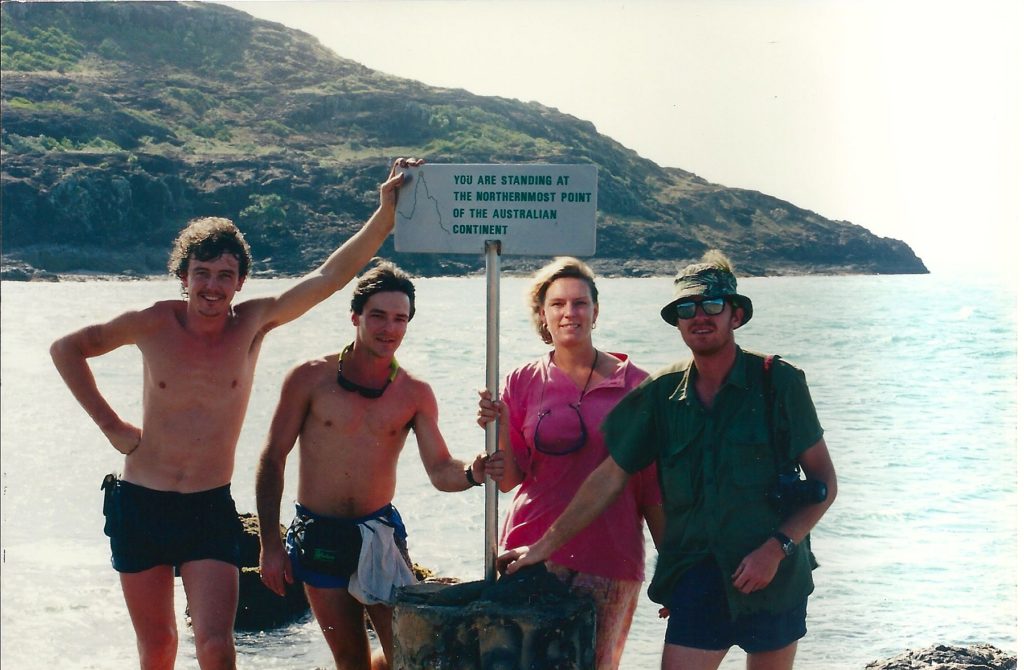
Standing at the tip of Australia, 1993. The guy on the far left without the hat is Joanna’s husband – now 25 years and two kids later!
Peter Then you rode Apache horses across Monument Valley on the Arizona-Utah border.
Joanna Well, that was amazing. I used to always go horseback riding. And in fact, on our honeymoon we went off around Calgary and we did the grizzly bear route and we had about five pack horses. There were five of us and we had this wonderful lady who was our leader who was called Anna Fontana. And Anna Fontana was an owner of a ranch and she was our leader. And for three weeks we just went through all grizzly bear country, which was really quite extraordinary, it was a wonderful experience.
And we took the kids a few years ago, we went in an RV and were travelling around America and we’d seen these old cowboy films with them galloping through Monument Valley. And I thought: wow, they’d been chased by the Red Indians, the Apaches, and I just thought it would be amazing to see Monument Valley area. And that was an opportunity to ride horses. And I just thought we can’t miss this. So we went riding off, the four of us in the sunset on Apache horses around Monument Valley during sunset.
That was, again, another magical moment. My husband is a very good horse rider, he was off all over the place, but I was a little bit more reserved. But it was great, absolutely amazing.
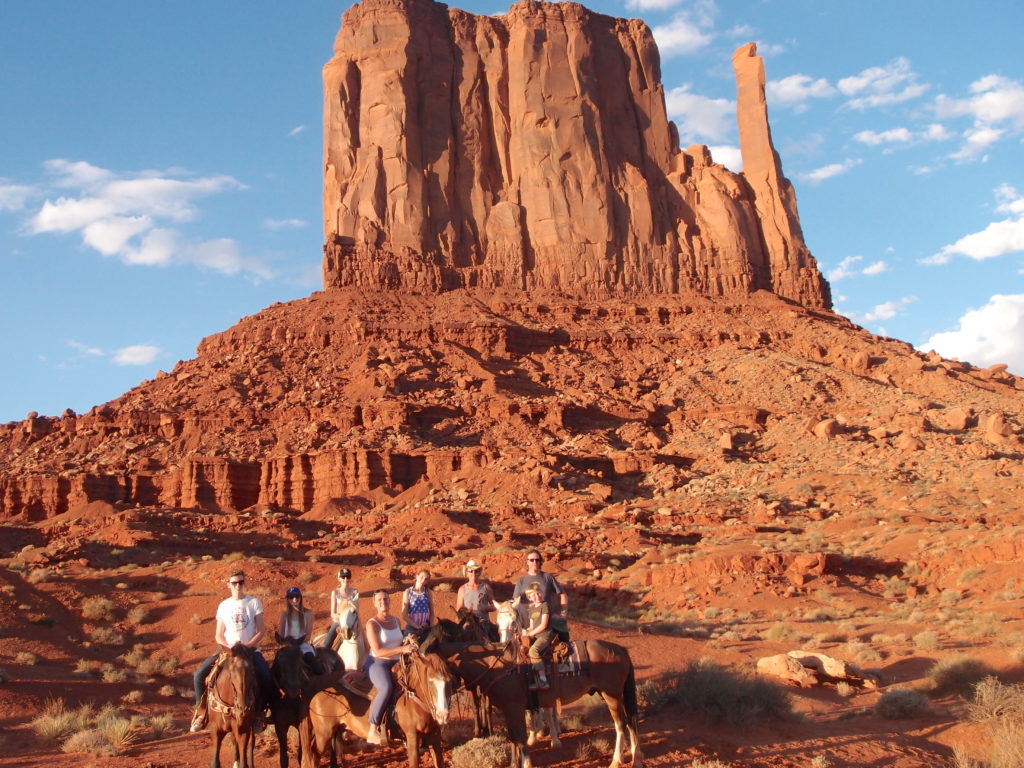
Family riding trip in Monument Valley, 2013
Felice And finally, what’s the most beautiful, the best, most beautiful gem or piece of jewellery I’ve ever seen?
Joanna Well, they’re usually a complete surprise. When I was at Phillips, I’d really just come out of the gemology classroom, I suppose only about five years or so. It’s always handy if you look older to give people bad news. It’s not very good to look young and give people bad news, because they think: ‘What do you know? You’ve been doing it for five minutes.’
This lady came into Phillips and she showed me a ruby and I looked at it and I could instantly tell that it was a synthetic. Anyway, I asked her what did she think she had and she said: ‘Oh, we’ve had it in the family for years and we now need the money, and so I want to sell it so that we can distribute it around the family.’ And she had obviously quite high expectations of this ruby, and I just thought what am I going to tell her? So I went behind the scenes to look through the microscope just to double-check if my gut feeling was right. And it was.
So I invited her into the small room. We had a small room for private clients or when you need some privacy. I offered her glass of water – I thought I should really be offering you a gin and tonic; I think you’ll want a gin by the time I’ve finished talking to you. I sat down and eventually I said: ‘Look, I’m really sorry, but this ring is synthetic and it’s worth about £5.’ And she just said: ‘Oh, I knew that. I was just testing you.’ So I thought: ‘What? After what you’ve put me through?’ Anyway, off she went. Then she came back two weeks later with two five-carat diamonds. And I think at the time I said there were about £50,000 each or something like that. And she just sort of nodded and left again.
I thought, you have got something. You are just checking me out. Then I got a phone call and she said: ‘Would you have tea with me in Brown’s the hotel in Albermarle Street in London. And off I off I toddled and sat there with her and she was just an Indian princess and I remember her and these wonderful, colourful saris. She said, ‘I want you to fly with me to my vaults. So I knew I was drawn to you for a reason.’
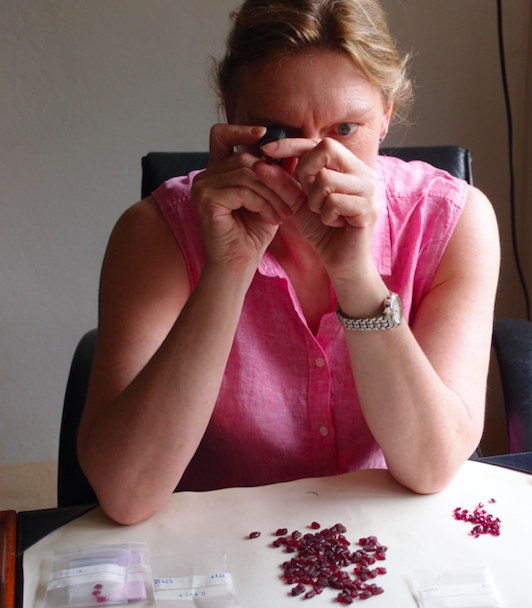
Looking at rubies
I said: ‘Oh, okay, that’s that’s very nice.’ So I went back to the office and I just said to my boss: ‘I’m going to someone’s vaults in Geneva next week. Is that okay?’ And he said, ‘Would you like to have a guard with you?’ And I wouldn’t know. Probably best not, because she doesn’t seem to like too much exposure.
So off I flew, went to Geneva and opened the vault and there was the real ruby ring. There was also a beautiful pair of art deco Cartier emerald drop ear pendants, a beautiful ruby and diamond deco bracelet, and this amazing pink diamond, which was the size of my thumbnail. And it was an emerald-cut, bright candy-floss pink.
I’d just never seen anything like this in my life. She wanted me to value it. I thought, well, I haven’t got the first clue. So I phoned a friend, as you do. So I phoned a colleague of mine who was in Geneva, and I said: ‘Would you mind coming over here? I’ve got something to show you.’ So he came over and we had a look at it and we thought it’s probably going to be, as an educated guess, about £2m, which was in 1992. I mean, that was a lot of money for a pink diamond and certainly it felt like a lot of money for us to quote on. And she said: ‘Oh, that’s lovely. Well, you can sell it then.’
So we did eventually. Well then I went on my walkabout in fact we didn’t sell it until I came to Sotheby’s and she then sold it at Sotheby’s. It went for $6.2m dollars and it was the world record price for a pink diamond at the time.
Often people say, what would you like to see again? Oh, I would love to see the 7.37 carat – I never forget the weight of the stone – in a Cartier mount, a beautiful pink diamond. The nearest I’ve seen that pink colour is the Queen has the Williamson Pink Diamond Brooch that she sometimes wears – with a very large pink diamond in it – and that’s about as close to the colour that I have ever seen. So that would be lovely to be able to see again. But that’s hopefully being enjoyed by someone, whoever that might be.
What was lovely when working at Sotheby’s, you went to all over the world. I valued the most amazing collections, private collectors. You would also go on spec, you would just go and sit in an office or you would put an advertisement out and get replies on the advertisement, and then you would go off and see these people in their homes. And this happened once in the Channel Islands. My colleague and I, we went round the houses replying to the advertisements; we’d go into their homes and they’d show us the jewellery and we would give them an idea of how much we think the pieces would make in auction.
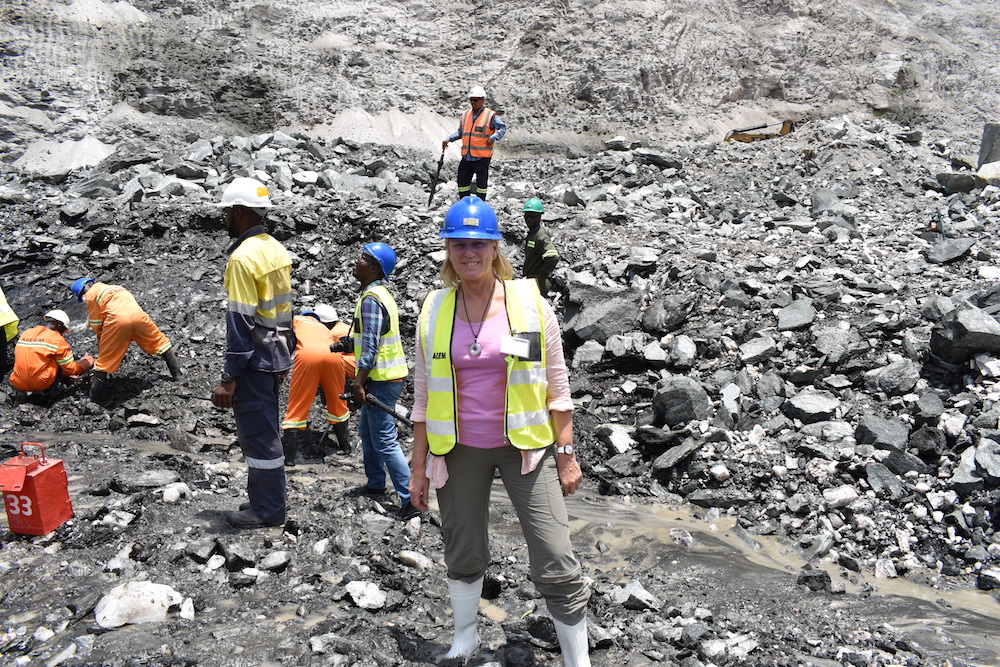
Joanna in Zambian Kagem Gemfields emerald mine
We went to this one place and this lady had a whole load of gold, just loads of just gold jewellery, which was really just sort of scrap value. And then she handed me this ring and it was absolutely filthy. I could hardly see it – it was just absolutely filthy. And she said ‘This used to be my mother in law’s and just wondered what you thought.’ It was a square stone; it was blue was the size of my thumbnail. And she said: ‘A jeweller thought it might be a topaz or aquamarine.’ Anyway, she really did like talking, she just talked and talked and talked and talked and talked at you. I think she was just very pleased to see somebody because she lived on her own.
Anyway, she talked a lot in between that time. I said: ‘Do you have an old toothbrush? And could I just use your sink and some fairy liquid or some soap so I can clean the ring?’ So I went into a kitchen; she was still talking at me, and I started to clean her ring. Obviously, I put the plug in the sink. That’s that’s always what you do, when you’re cleaning any jewellery, you always make sure the plug is in the sink. As she was talking and I was cleaning and cleaning, it was getting blue and bluer. I looked at it with my loop and it was a blue diamond. I just turned round to her and I said: ‘This is worth about £1m.’ And she stopped talking. There was silence. I just thought, oh, I should have said that earlier. She was absolutely gobsmacked: ‘I had no idea,’ and she said: ‘Oh, well, you better sell it then, please.’ So I walked out with this blue diamond worth a million pounds and I had to get it to Geneva.
Suddenly you feel like you’ve got sort of a sign across your face ‘Mug me now, I’m worth £1m.’ That was all a long time ago. It is a very different world now; no one walks anywhere with anything anymore, but it was just very funny at the time. And it’s just wonderful to discover things when people had no idea themselves of what they have.
Felice Joanna Hardy, thank you so much for coming on the show. It’s been great talking to you.
Joanna Well, thank you very much for allowing me to indulge and remember all my wonderful adventures. I hope to have lots more.
Peter You can find out more about Joanna Hardy, and her courses and books, on her website JoannaHardy.com
Felice That’s all for now. If you’ve enjoyed the show, please share this episode with at least one other person! Do also subscribe on Spotify, i-Tunes, Stitcher, or any of the many podcast providers – where you can give us a rating. You can also find us on Twitter, Facebook and Instagram. Stay safe and we’ll see you next week.
© Action Packed Travel

- Join over a hundred thousand podcasters already using Buzzsprout to get their message out to the world.
- Following the link lets Buzzsprout know we sent you, gets you a $20 Amazon gift card if you sign up for a paid plan, and helps support our show.

